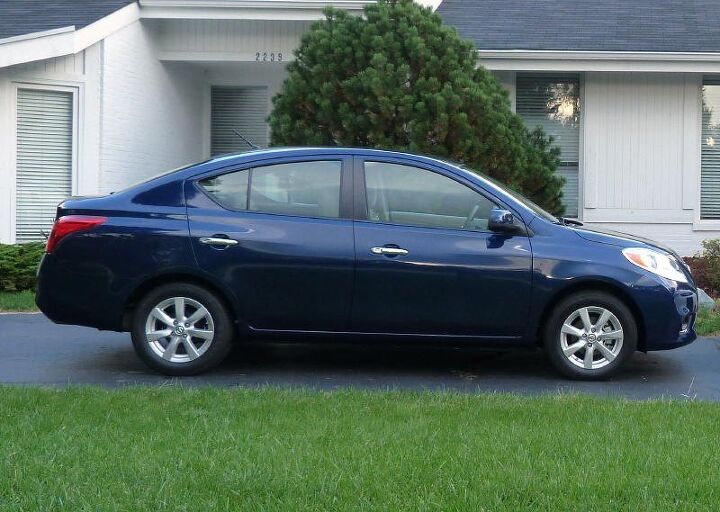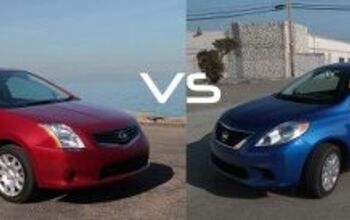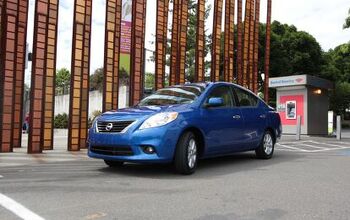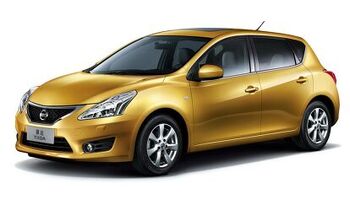Review: 2012 Nissan Versa
Do you have automotive tastes common among people of a certain age? Not a fan of huge wheels or firm seats? Want something economical? Meet the new 2012 Nissan Versa.
Some small cars are comfortable with their small car-ness. Others, not so well-adjusted, put on airs well above their station. Like more than a few post-war European sedans, the new Versa falls into the latter camp. A high, bulbous front end strives for big car road presence, but tall, narrow proportions blow the charade. In the side profile, a stylishly plunging roof line primarily succeeds in truncating rear headroom, combined as it is with a bulbous nose, barn door bodysides, and (by current standards) tiny 15-inch wheels. When the Chinese knock off the new Versa they might actually improve it.
As long as you don’t look closely or touch anything, the interior of the 2012 Versa almost passes as luxurious, with chrome highlights and the taupe/tan color scheme that’s been a Lexus staple since the first LS 400 rolled off the boat. High-mounted, spongy seats continue the “compact luxury” play. But the hard plastic door-mounted armrests do not—those in a high-end previous generation Versa were far more amenable to elbows. If there’s a design here it’s certainly not a coherent one. The tall, chunky center stack would be more at home in an MPV. In the Versa it locates the audio system controls beyond easy reach. And the climate control area at its base…I haven’t a clue what the designer was thinking. Shame about the impact of the plunging roof line on rear headroom, as there’s substantially more rear legroom than in most competitors.
Compared to the previous-generation Versa (which lives on in hatchback form), the new one is about the same size but, at just over 2,400 pounds, over 300 pounds lighter. The weight loss is welcome, as an uncouth 109-horsepower 1.6-liter engine is no longer just the base engine—it’s the only engine. Paired with a CVT (a five-speed manual is offered only on the base S trim), the 1.6 moves the flyweight car well enough. According to the stopwatch, anyway. Your ears will report all of the side effects that have made CVTs as (un)popular as they are today. Nissan has some passable CVT implementations that don’t inspire thoughts of rubber bands, slipping clutches, and angry lawn care equipment. This isn’t one of them.
The EPA fuel economy ratings of 30 city, 38 highway, while much better than the 2011 1.8SL’s 24/32, don’t quite match the segment’s best. But you’d never know this from the trip computer, which reports over 40 (even 46 for one light-footed fifteen-mile trip) in typical suburban driving. Trip computers can be optimistic, but the gas gauge (Nissan’s traditional orange LCDs) moved less over the course of a day than some move while idling at a traffic light.
The suspension is tuned much like the seats, so there’s copious body roll in turns, limited grip, and considerable bobbling about over poorly maintained roads. No dynamic surprises, though, aside from the modest amounts of understeer and tire squeal (credit the 185/65HR15 Continental ContiProContacts for the latter). Noise levels (when the CVT isn’t doing its thing) are in line with current competitors, so much lower than the bygone B-segment norm.
Clearly, the new Versa was engineered to hit a low price point, and does start at $11,750, $1,455 lower than the 2012 Accent, the second-cheapest car currently offered in the U.S. And the Versa, unlike the Accent, comes standard with conditioned air. Live large with an SL like the car reviewed and the sticker jumps to $16,320. Not so cheap, but over $1,700 less than a 2011 SL with Convenience Package (for the now standard Bluetooth). The 2011 did include about $700 in additional features according to TrueDelta’s Car Price Comparison Tool—some luxuries like keyless ignition, leather-wrapped steering wheel, center armrests, and a passenger-side vanity mirror are no longer available—but this still leaves the 2012 a grand more affordable.
Unfortunately, the price cut only brings the Versa 1.6 SL in line with superior competitors. A Ford Fiesta SE with SYNC and Sport Appearance Packages lists for nearly $1,000 more, but includes over $1,000 in additional features. The story is much the same with the new Hyundai Accent GLS with Comfort and Premium Packages: $900 higher sticker, but over $700 in additional features.
So the new Versa isn’t a value play. Financially, it only makes sense—in base trim—for those who must pay as little as possible for that new car smell. In as-tested SL trim the Versa leads the competition in hardly anything, trails them in many things, and costs about the same. So who’s going to buy it? As noted in the introduction, not everyone is a fan of the latest automotive trends. Those seeking the character of a post-Reuss, pre-Lutz Buick, in a much smaller, more economy-minded package, will find what they’re looking for here.
Nissan provided the vehicle, insurance and one tank of gas for this review.
Michael Karesh operates TrueDelta, an online source of automotive pricing and reliability data.
Michael Karesh lives in West Bloomfield, Michigan, with his wife and three children. In 2003 he received a Ph.D. from the University of Chicago. While in Chicago he worked at the National Opinion Research Center, a leader in the field of survey research. For his doctoral thesis, he spent a year-and-a-half inside an automaker studying how and how well it understood consumers when developing new products. While pursuing the degree he taught consumer behavior and product development at Oakland University. Since 1999, he has contributed auto reviews to Epinions, where he is currently one of two people in charge of the autos section. Since earning the degree he has continued to care for his children (school, gymnastics, tae-kwan-do...) and write reviews for Epinions and, more recently, The Truth About Cars while developing TrueDelta, a vehicle reliability and price comparison site.
More by Michael Karesh
Latest Car Reviews
Read moreLatest Product Reviews
Read moreRecent Comments
- Akear Does anyone care how the world's sixth largest carmaker conducts business. Just a quarter century ago GM was the world's top carmaker. [list=1][*]Toyota Group: Sold 10.8 million vehicles, with a growth rate of 4.6%.[/*][*]Volkswagen Group: Achieved 8.8 million sales, growing sharply in America (+16.6%) and Europe (+20.3%).[/*][*]Hyundai-Kia: Reported 7.1 million sales, with surges in America (+7.9%) and Asia (+6.3%).[/*][*]Renault Nissan Alliance: Accumulated 6.9 million sales, balancing struggles in Asia and Africa with growth in the Americas and Europe.[/*][*]Stellantis: Maintained the fifth position with 6.5 million sales, despite substantial losses in Asia.[/*][*]General Motors, Honda Motor, and Ford followed closely with 6.2 million, 4.1 million, and 3.9 million sales, respectively.[/*][/list=1]
- THX1136 A Mr. J. Sangburg, professional manicurist, rust repairer and 3 times survivor is hoping to get in on the bottom level of this magnificent property. He has designs to open a tea shop and used auto parts store in the facility as soon as there is affordable space available. He has stated, for the record, "You ain't seen anything yet and you probably won't." Always one for understatement, Mr. Sangburg hasn't been forthcoming with any more information at this time. You can follow the any further developments @GotItFiguredOut.net.
- TheEndlessEnigma And yet government continues to grow....
- TheEndlessEnigma Not only do I not care about the move, I do not care about GM....gm...or whatever it calls itself.
- Redapple2 As stated above, gm now is not the GM of old. They say it themselves without realizing it. New logo: GM > gm. As much as I dislike my benefactor (gm spent ~ $200,000 on my BS and MS) I try to be fair, a smart business makes timely decisions based on the reality of the current (and future estimates) situation. The move is a good one.
















































Comments
Join the conversation
When Nissan broke the last gen car to the public... They actually sold more of the hatches than the sedans. So what does Nissan do on this version? REVERSE IT... Lets sell more shit sedans... Who wants a stripper hatch?! Id like an answer for that. Why wouldnt they want the hatch selling better than the sedan. They already have a other gutless dirtbox (Sentra) that would be fine as a basic sedan. In the end.. This car doesn't have a point.. unless it has the hatch
Sounds like a big step backwards. Too bad. You'd think that the maker of the Datsun 510 and Sentra SE-R would be doing at least as well as Mazda in this segment today, but Nissan's approach to its small cars seems pretty schizophrenic.